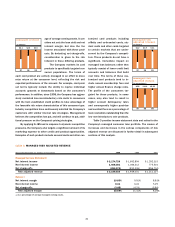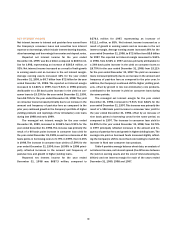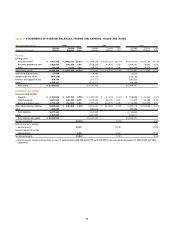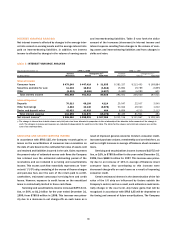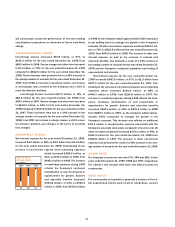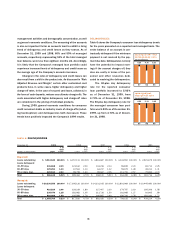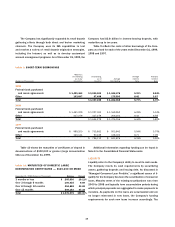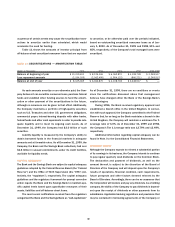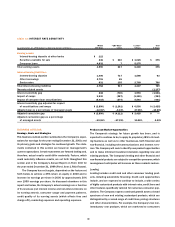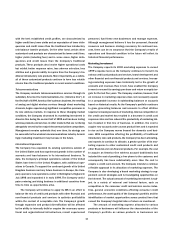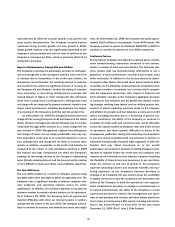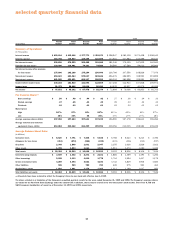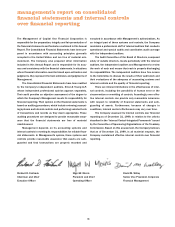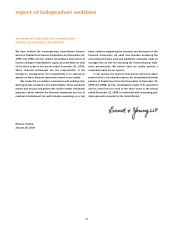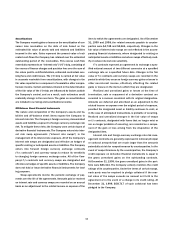Capital One 1999 Annual Report Download - page 42
Download and view the complete annual report
Please find page 42 of the 1999 Capital One annual report below. You can navigate through the pages in the report by either clicking on the pages listed below, or by using the keyword search tool below to find specific information within the annual report.
41
its subsidiaries may restrict the ability of the Company’s sub-
sidiaries to pay dividends to the Corporation or the ability of the
Corporation to pay dividends to its stockholders.
OFF-BALANCE SHEET RISK
The Company is subject to off-balance sheet risk in the normal
course of business including commitments to extend credit,
reduce the interest rate sensitivity of its securitization transac-
tions and its off-balance sheet financial instruments. The
Company enters into interest rate swap agreements in the man-
agement of its interest rate exposure. The Company also enters
into forward foreign currency exchange contracts and currency
swaps to reduce its sensitivity to changing foreign currency
exchange rates. These off-balance sheet financial instruments
involve elements of credit, interest rate or foreign currency
exchange rate risk in excess of the amount recognized on the
balance sheet. These instruments also present the Company
with certain credit, market, legal and operational risks. The
Company has established credit policies for off-balance sheet
instruments as it has for on-balance sheet instruments.
Additional information regarding off-balance sheet finan-
cial instruments can be found in Note N to the Consolidated
Financial Statements.
INTEREST RATE SENSITIVITY
Interest rate sensitivity refers to the change in earnings that
may result from changes in the level of interest rates. To the
extent that managed interest income and expense do not
respond equally to changes in interest rates, or that all rates
do not change uniformly, earnings could be affected. The
Company’s managed net interest income is affected by changes
in short-term interest rates, primarily the London InterBank
Offering Rate, as a result of its issuance of interest-bearing
deposits, variable rate loans and variable rate securitizations.
The Company manages and mitigates its interest rate sensitiv-
ity through several techniques which include, but are not limited
to, changing the maturity, repricing and distribution of assets
and liabilities and entering into interest rate swaps.
The Company measures exposure to its interest rate risk
through the use of a simulation model. The model generates a
distribution of possible twelve-month managed net interest
income outcomes based on (i) a set of plausible interest rate
scenarios, as determined by management based upon historical
trends and market expectations, (ii) all existing financial instru-
ments, including swaps, and (iii) an estimate of ongoing
business activity over the coming twelve months. The Company’s
asset/liability management policy requires that based on this
distribution there be at least a 95% probability that managed
net interest income achieved over the coming twelve months
will be no more than 3% below the mean managed net interest
income of the distribution. As of December 31, 1999, the
Company was in compliance with the policy; more than 99% of
the outcomes generated by the model produced a managed net
interest income of no more than 1.3% below the mean out-
come. The interest rate scenarios evaluated as of December 31,
1999 included scenarios in which short-term interest rates rose
in excess of 400 basis points or fell by as much as 175 basis
points over twelve months.
The analysis does not consider the effects of the changed
level of overall economic activity associated with various inter-
est rate scenarios. Further, in the event of a rate change of large
magnitude, management would likely take actions to further
mitigate its exposure to any adverse impact. For example, man-
agement may reprice interest rates on outstanding credit card
loans subject to the right of the consumers in certain states to
reject such repricing by giving timely written notice to the
Company and thereby relinquishing charging privileges. How-
ever, the repricing of credit card loans may be limited by
competitive factors as well as certain legal constraints.
Interest rate sensitivity at a point in time can also be ana-
lyzed by measuring the mismatch in balances of earning assets
and interest-bearing liabilities that are subject to repricing in
future periods.
Table 12 reflects the interest rate repricing schedule
for earning assets and interest-bearing liabilities as of Decem-
ber 31, 1999.
SUBSEQUENT EVENTS
On February 22, 2000, the Company’s Board of Directors
approved the repurchase of up to 10,000,000 shares of the
Company’s common stock over the next two years, in addition
to the 2,250,000 shares then remaining under the Company’s
repurchase programs approved in 1997 and 1998. As of Feb-
ruary 29, 2000, the Company had 10,846,400 shares available
for repurchase under these programs.


